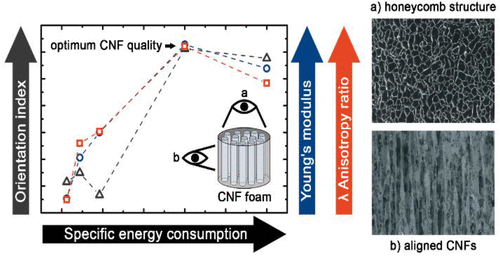当前位置:
X-MOL 学术
›
ACS Sustain. Chem. Eng.
›
论文详情
Our official English website, www.x-mol.net, welcomes your feedback! (Note: you will need to create a separate account there.)
Analysis of the Porous Architecture and Properties of Anisotropic Nanocellulose Foams: A Novel Approach to Assess the Quality of Cellulose Nanofibrils (CNFs)
ACS Sustainable Chemistry & Engineering ( IF 8.4 ) Pub Date : 2018-07-18 00:00:00 , DOI: 10.1021/acssuschemeng.8b02278 Konstantin Kriechbaum 1 , Pierre Munier 1 , Varvara Apostolopoulou-Kalkavoura 1 , Nathalie Lavoine 1
ACS Sustainable Chemistry & Engineering ( IF 8.4 ) Pub Date : 2018-07-18 00:00:00 , DOI: 10.1021/acssuschemeng.8b02278 Konstantin Kriechbaum 1 , Pierre Munier 1 , Varvara Apostolopoulou-Kalkavoura 1 , Nathalie Lavoine 1
Affiliation

|
Cellulose nanofibrils (CNFs) are a unique nanomaterial because of their abundant, renewable, and biocompatible origin. Compared with synthetic nanoparticles, CNFs are commonly produced from cellulose fibers (e.g., wood pulp) by repetitive high-shear mechanical disintegration. Yet, this process is still highly demanding in energy and costly, slowing down the large-scale production and commercialization of CNFs. Reducing the energy consumption during fibers fibrillation without using any chemical or enzymatic pretreatments while sustaining the CNF quality is challenging. Here, we show that the anisotropic properties of the CNF foams are directly connected to the degree of nanofibrillation of the cellulose fibers. CNFs were produced from wood pulps using a grinder at increasing specific energy consumptions. The anisotropic CNF foams were made by directional ice templating. The porous architecture, the compressive behavior of the foams, and the CNF alignment in the foam cell walls were correlated to the degree of fibrillation. A particular value of specific energy consumption was identified with respect to the highest obtained foam properties and CNF alignment. This value indicated that the optimal degree of fibrillation, and thus CNF quality, was achieved for the studied cellulose pulp. Our approach is a straightforward tool to evaluate the CNF quality and a promising method for the benchmarking of different CNF grades.
中文翻译:

各向异性纳米纤维素泡沫的多孔结构和性能分析:评估纤维素纳米原纤维(CNFs)质量的一种新方法。
纤维素纳米原纤维(CNF)是一种独特的纳米材料,因为其来源丰富,可再生且具有生物相容性。与合成纳米颗粒相比,CNF通常是由纤维素纤维(例如木浆)通过反复的高剪切机械崩解来生产的。然而,该过程仍然对能量和成本要求很高,从而减慢了CNF的大规模生产和商业化。在保持CNF质量的同时,不使用任何化学或酶促预处理方法来降低纤维原纤化过程中的能量消耗是具有挑战性的。在这里,我们表明,CNF泡沫的各向异性与纤维素纤维的纳米原纤化程度直接相关。CNFs是使用研磨机从木浆中以增加的单位能耗来生产的。各向异性CNF泡沫是通过定向冰模板制备的。多孔结构,泡沫的压缩行为以及泡沫孔壁中的CNF排列与原纤维化程度相关。相对于获得的最高泡沫性能和CNF取向,确定了比能耗的特定值。该值表明所研究的纤维素纸浆达到了最佳的原纤化程度,从而达到了CNF质量。我们的方法是评估CNF质量的直接工具,并且是对不同CNF等级进行基准测试的有前途的方法。关于获得的最高泡沫性能和CNF排列,确定了比能耗的特定值。该值表明所研究的纤维素纸浆达到了最佳的原纤化程度,从而达到了CNF质量。我们的方法是评估CNF质量的直接工具,并且是对不同CNF等级进行基准测试的有前途的方法。关于获得的最高泡沫性能和CNF排列,确定了比能耗的特定值。该值表明所研究的纤维素纸浆达到了最佳的原纤化程度,从而达到了CNF质量。我们的方法是评估CNF质量的直接工具,并且是对不同CNF等级进行基准测试的有前途的方法。
更新日期:2018-07-18
中文翻译:

各向异性纳米纤维素泡沫的多孔结构和性能分析:评估纤维素纳米原纤维(CNFs)质量的一种新方法。
纤维素纳米原纤维(CNF)是一种独特的纳米材料,因为其来源丰富,可再生且具有生物相容性。与合成纳米颗粒相比,CNF通常是由纤维素纤维(例如木浆)通过反复的高剪切机械崩解来生产的。然而,该过程仍然对能量和成本要求很高,从而减慢了CNF的大规模生产和商业化。在保持CNF质量的同时,不使用任何化学或酶促预处理方法来降低纤维原纤化过程中的能量消耗是具有挑战性的。在这里,我们表明,CNF泡沫的各向异性与纤维素纤维的纳米原纤化程度直接相关。CNFs是使用研磨机从木浆中以增加的单位能耗来生产的。各向异性CNF泡沫是通过定向冰模板制备的。多孔结构,泡沫的压缩行为以及泡沫孔壁中的CNF排列与原纤维化程度相关。相对于获得的最高泡沫性能和CNF取向,确定了比能耗的特定值。该值表明所研究的纤维素纸浆达到了最佳的原纤化程度,从而达到了CNF质量。我们的方法是评估CNF质量的直接工具,并且是对不同CNF等级进行基准测试的有前途的方法。关于获得的最高泡沫性能和CNF排列,确定了比能耗的特定值。该值表明所研究的纤维素纸浆达到了最佳的原纤化程度,从而达到了CNF质量。我们的方法是评估CNF质量的直接工具,并且是对不同CNF等级进行基准测试的有前途的方法。关于获得的最高泡沫性能和CNF排列,确定了比能耗的特定值。该值表明所研究的纤维素纸浆达到了最佳的原纤化程度,从而达到了CNF质量。我们的方法是评估CNF质量的直接工具,并且是对不同CNF等级进行基准测试的有前途的方法。



























 京公网安备 11010802027423号
京公网安备 11010802027423号